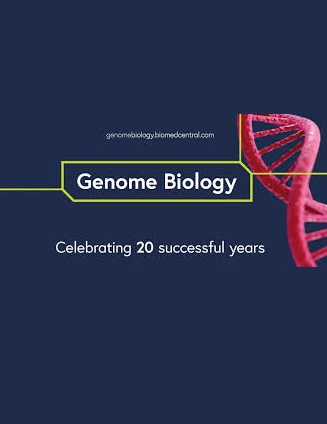SlideCNA:从类似slide -seq的空间转录组学数据中检测空间拷贝数改变
IF 10.1
1区 生物学
Q1 BIOTECHNOLOGY & APPLIED MICROBIOLOGY
引用次数: 0
摘要
实体肿瘤在遗传、分子和细胞组成上具有空间异质性,但最近的空间分析研究主要是分别绘制肿瘤的遗传和RNA变异。为了利用RNA识别拷贝数改变(CNA)的潜力,我们开发了SlideCNA,这是一种计算工具,可以以接近单细胞的分辨率从稀疏的空间转录组学数据中提取CNA信号。SlideCNA使用表达感知的空间分组来克服稀疏性限制,同时保持空间信号以恢复CNA模式。我们在模拟和真实的(转移性)乳腺癌的Slide-seq数据上测试了SlideCNA,并证明了它在空间亚克隆检测方面的潜力。本文章由计算机程序翻译,如有差异,请以英文原文为准。
SlideCNA: spatial copy number alteration detection from Slide-seq-like spatial transcriptomics data
Solid tumors are spatially heterogeneous in their genetic, molecular, and cellular composition, but recent spatial profiling studies have mostly charted genetic and RNA variation in tumors separately. To leverage the potential of RNA to identify copy number alterations (CNAs), we develop SlideCNA, a computational tool to extract CNA signals from sparse spatial transcriptomics data with near single cellular resolution. SlideCNA uses expression-aware spatial binning to overcome sparsity limitations while maintaining spatial signal to recover CNA patterns. We test SlideCNA on simulated and real Slide-seq data of (metastatic) breast cancer and demonstrate its potential for spatial subclone detection.
求助全文
通过发布文献求助,成功后即可免费获取论文全文。
去求助
来源期刊

Genome Biology
Biochemistry, Genetics and Molecular Biology-Genetics
CiteScore
21.00
自引率
3.30%
发文量
241
审稿时长
2 months
期刊介绍:
Genome Biology stands as a premier platform for exceptional research across all domains of biology and biomedicine, explored through a genomic and post-genomic lens.
With an impressive impact factor of 12.3 (2022),* the journal secures its position as the 3rd-ranked research journal in the Genetics and Heredity category and the 2nd-ranked research journal in the Biotechnology and Applied Microbiology category by Thomson Reuters. Notably, Genome Biology holds the distinction of being the highest-ranked open-access journal in this category.
Our dedicated team of highly trained in-house Editors collaborates closely with our esteemed Editorial Board of international experts, ensuring the journal remains on the forefront of scientific advances and community standards. Regular engagement with researchers at conferences and institute visits underscores our commitment to staying abreast of the latest developments in the field.
 求助内容:
求助内容: 应助结果提醒方式:
应助结果提醒方式:


